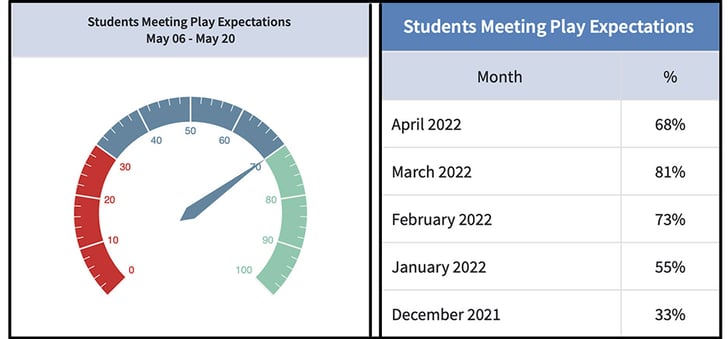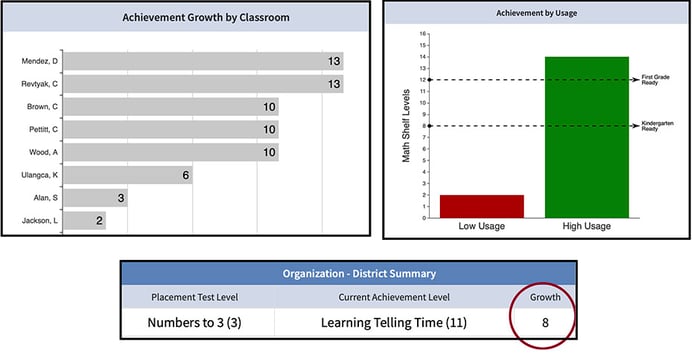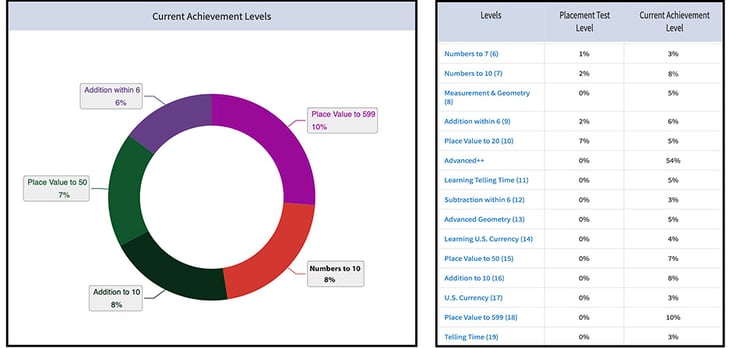Math Shelf Data Reports
Measuring young children's math knowledge is critical for planning instruction, intervening early, and ensuring each student's future school success. Math Shelf Data Reports measure children's usage, math learning growth, and math achievement. Data REports are emailed to teachers and administrators weekly throughout the school year. This blog post describes how to interpret Math Shelf Data Reports and use data consistently to improve children's math achievement.
Math Shelf Usage
In order to learn math, students need consistent opportunities to practice. Having usage goals helps teachers and administrators keep track that every student is playing Math Shelf consistently. Our recommended usage is that, "70% of students play Math Shelf twice a week for 10 minutes each session." The chart below in your data reports measures Math Shelf usage.

The Speedometer shows that for the first two weeks of May, 70% of students played Math Shelf twice a week for 10 minutes each session. The table to the right reports Math Shelf usage for each month of implementation.
Math Shelf Learning Growth
Math Shelf is a comprehensive pre-K and Kindergarten program that includes over 1,500 math games and activities grouped into 22 Skill Levels. The average child that plays Math Shelf twice a week for 10 minutes each sessions typically grows between 1-and-2 math levels per month. We encourage educators to set their growth goal at 1 Math Shelf Level per month. 
The chart to the top left lists students' learning growth by classroom (Ms. Mendez's class grew 13 levels). The chart to the right shows growth by Math Shelf Usage. High Usage students grew much more in math than low usage children. And, the table at the bottom displays the average student's growth from the beginning of the year to the current date.
Math Shelf Achievement
Achievement goals state the math skills and knowledge that educators expect students to master by the end of the school year. In Math Shelf, Kindergarten students should master Level 12 (Subtraction within 6) to be ready for first grade. This means pupils know addition/subtraction within 6, place value to 20, measurement, geometry, and counting and cardinality to 120.
Pre-K students should master Math Shelf Level 8 (Measurement) and all previous skills such as Number Sense to 10, shapes and spatial awareness, measurement, patterns, classification, and sequencing. Below are example Kindergarten and Pre-K Math Shelf achievement goals:
- 80% of Kindergarten students complete the year at Math Shelf Level 12 or above (e.g., they are 1st grade math ready)
- 80% of Pre-K students complete the year at Math Shelf Level 8 or above (e.g., they are Kindergarten math ready).

The table to the right shows that 54% of students are in the Advanced math levels. Approximately, half of the Kindergarteners in this school are 1st grade math ready. There are two months of instruction remaining to work with students to meet the school's math achievement goal.
Conclusion
Math Shelf Data Reports measure students' usage, math learning growth, and math achievement. By setting goals prior to implementing Math Shelf, educators can analyze students math data against these goals to help every student maximize their math learning potential.


